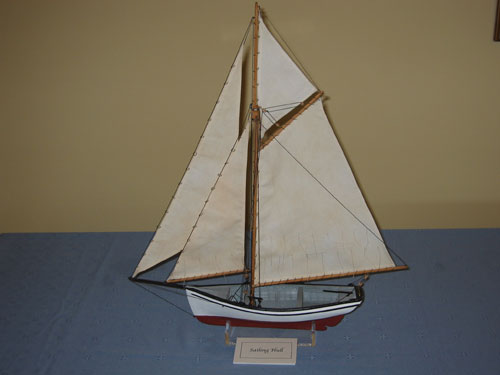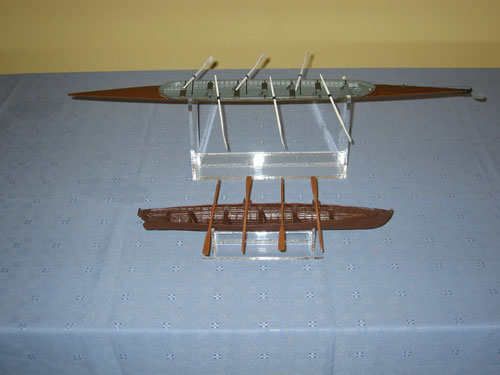
DIMENSIONS OF CURRENT SHELLS
During the first decades of recorded Regatta history, the commercial boats of the day were used. These included whaleboats, jolly boats, punts, gigs, and sail-boats. These are different styles of boats, which led to the belief that the boats themselves were giving the crews different advantages and disadvantages.
Building a standard
 Scale model of a sailing scull from the Regatta Museum. Models were constructed by Kurt Mahle.
|
By the 1840's, race organizers had decided that it would be a good idea to
improve the quality of the races by attempting to standardize the boats being
used. As such, they sought the development of specialized race boats from
builders in Halifax and St.John's.
Before Robert Sexton came onto the scene with such legendary boats as the Blue Peter, the person building competitive racing boats that compared to the boats being made in Halifax was Sam Loveys. He built such boats as Ripple, Lucy Long, Darling, Undeen, and Eugenie. As with any change, this was met with opposition from persons who believed that the purity of the races existed in the fact that the boats of the trade were being used. |
From 1861-1871, there were no races held at Quidi Vidi. This allowed for boat builders to improve their craft by building boats for other racing competitions held throughout the country. During the 1870's, the boats built by Fred Lewis (Lady of the Lake), Ned Sinnott (Placentia, later renamed Contest), and others made their way into Regatta history - either through victory, loss, or, as was the case with the Terra Nova in 1884, tragedy. In 1886, the City Club purchased Avalon and two years later, in 1888, the team of Halleran and Herder built the Gypsy.
Of the most important design features incorporated into a racing boat , the size and weight of the shell would be among the top considerations.
|
 Scale model of a Jolly Boat from the Regatta Museum. Models were constructed by Kurt Mahle.
|
Bob Sexton builds The Glance
The biggest change was yet to come. In 1895, the first Bob Sexton boat, the Glance, was launched. It was met with much criticism. The design was that of Dr. H.H. Rendell, who would go on to design many of the Sexton boats. With a total length of 49 feet, it was longer and sleeker then any boat ever seen on the waters of Quidi Vidi. Committee members of the time commented that the boat was not practical for the races and it was likely to be swamped due to how low it sat in the water. It was also suggested that the boat would not be able to make the turn at the buoys due to its length. Skepticism quickly turned to quiet amazement as the Glance out performed the other boats on the pond and won thirteen first place prizes on a fourteen race programme. Rumor quickly spread that the boat had not been built locally at all, and was actually shipped from Halifax and reassembled in St.John's.
The concern of the Committee, however, was that if the Glance were allowed to compete
in subsequent races, the interest in the Regatta would dwindle. Thus, just a year later
in 1896, the Committee asked Rendell not to race his boat. He agreed, but under condition
that he be allowed to reconstruct another famous builder's boat. He was granted
permission to rebuild the Iris constructed by Phil Mahoney.
With the mattered settled, the Committee felt the races would be more competitive and interesting for the general public. To their surprise, the refurbished Iris resembled the Glance and indeed went on to win eleven out of fourteen races. |
 Scale models comparing a Jolly Boat (front) and the Blue Peter from the Regatta Museum. Models were constructed by Kurt Mahle.
|
This was the beginning of a new boat construction era in which Bob Sexton and Dr. Rendell were pivotal characters.
(continued on Page 2)





